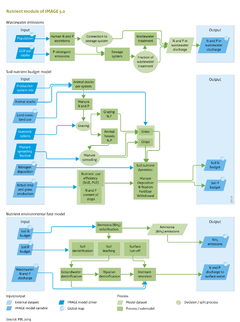Nutrients/Policy issues: Difference between revisions
Jump to navigation
Jump to search
Oostenrijr (talk | contribs) No edit summary |
Oostenrijr (talk | contribs) No edit summary |
||
| Line 1: | Line 1: | ||
{{ComponentPolicyIssueTemplate | {{ComponentPolicyIssueTemplate | ||
|Description=Under baseline scenarios of IMAGE, N surpluses generally increase. For example, in the Rio+20 baseline scenario, the N surplus increases by 35% globally in the period 2002-2050 ( | |Description=Under baseline scenarios of IMAGE, N surpluses generally increase. For example, in the Rio+20 baseline scenario, the N surplus increases by 35% globally in the period 2002-2050 (the figure below). This is the result of decreasing trends in North America, Western Europe and Japan as a result of increasing nutrient use efficiency, and stabilisation in India. In all other regions, N surpluses increase, particularly in Sub-Saharan Africa and Southeastern Asia as a result of increasing fertilizer use to halt soil nutrient depletion (the figure below). The situation is similar for P, with large increases in developing countries. | ||
|Example=Economic developments and policy interventions may modify individual terms in the soil nutrient budget (Formula 1, [[Nutrients/Description|Model description part]]), and the fate of nutrients in the environment. For example, agricultural demand (Component [[Agricultural economy]]) affects: | |Example=Economic developments and policy interventions may modify individual terms in the soil nutrient budget (Formula 1, [[Nutrients/Description|Model description part]]), and the fate of nutrients in the environment. For example, agricultural demand (Component [[Agricultural economy]]) affects: | ||
* production of leguminous crops (pulses and soybeans) and biological N fixation as a consequence; | * production of leguminous crops (pulses and soybeans) and biological N fixation as a consequence; | ||
| Line 18: | Line 18: | ||
* Dietary changes (DI), for example, assume that by 2050, 10% of beef consumption under the baseline scenarios is replaced by poultry meat in all producing regions, without accounting for changes in agricultural trade. | * Dietary changes (DI), for example, assume that by 2050, 10% of beef consumption under the baseline scenarios is replaced by poultry meat in all producing regions, without accounting for changes in agricultural trade. | ||
Extensification, increased feed efficiency and reduced ammonia emissions from stables (cases EX, FE and ST) have minor effects on the global soil N budget ( | Extensification, increased feed efficiency and reduced ammonia emissions from stables (cases EX, FE and ST) have minor effects on the global soil N budget (the figure below). However, better integration of animal manure in crop production systems (IM), primarily in industrialised countries, and a change in the human diet with poultry replacing ruminant meat (DI) would have major effects on the global soil N budget. | ||
Other options that can be assessed using scenario variables from other parts of IMAGE include: | Other options that can be assessed using scenario variables from other parts of IMAGE include: | ||
Revision as of 09:18, 24 June 2014
Parts of Nutrients/Policy issues
| Component is implemented in: |
| Components: |
| Related IMAGE components |
| Projects/Applications |
| Key publications |
